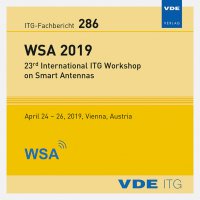Comparison of Two Baseline AoA Estimation Methods in a EM Lens Assisted MAA System
Conference: WSA 2019 - 23rd International ITG Workshop on Smart Antennas
04/24/2019 - 04/26/2019 at Vienna, Austria
Proceedings: WSA 2019
Pages: 5Language: englishTyp: PDF
Personal VDE Members are entitled to a 10% discount on this title
Authors:
Shaikh, Sarmad Ahmed (Department of Avionics Engineering, PAF-Karachi Institute of Economics and Technology, Karachi, Pakistan)
Tonello, Andrea M. (Institute of Networked and Embedded Systems, Alpen-Adria-Universität Klagenfurt, 9020 Klagenfurt, Austria)
Abstract:
The fifth generation (5G) of wireless systems will implement new groundbreaking technologies, for instance, massive multiple-input-multiple-output (MIMO) transmission. Such systems, by deploying massive antennas array (MAA), can enhance the data communication performance as well as offer precise radio localization based on angle of arrival (AoA) estimation. This paper considers two baseline AoA estimation techniques, namely complex conjugate AoA estimation and sum-difference patterns, when used in the electromagnetic (EM) lens assisted MAA system. Due to the property of the EM lens to focus the received signal on a small subset of antennas, these schemes can be implemented in the MAA system with reduced computational complexity using a fully digital or a mixed analog-digital structure. The presented techniques estimate the AoA of a received signal by exploiting two elements of the focused subset of antennas and alleviate the need of using high-resolution algorithms which form the high dimensional covariance and eigenvalue decomposition matrices. The obtained simulation results are comparable to the conventional algorithms without lens, despite significantly reducing the overall system complexity.


